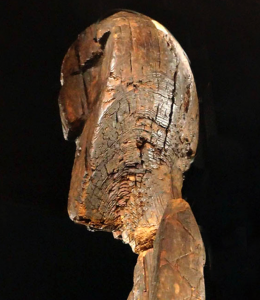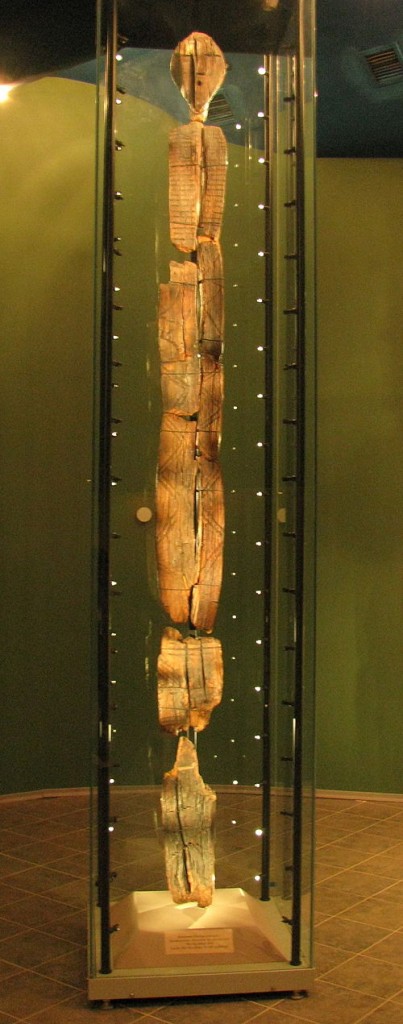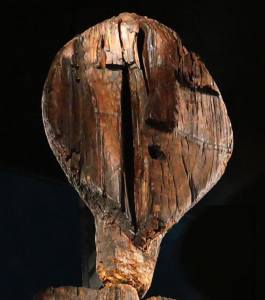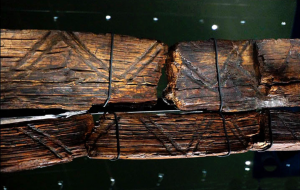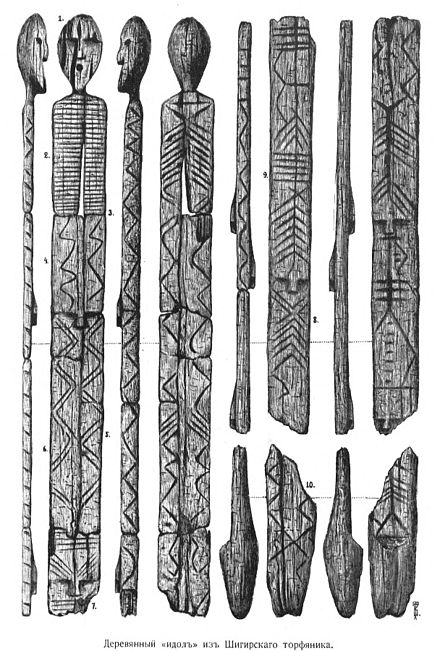Shigir Idol in Yekaterinberg confirmed as the world’s oldest wooden monument
Oct 18th, 2015 | By Ivan Lindsay | Category: JournalThe Shigir Idol, a Totem Pole type figure, has recently been dated by German archaeologists in Mannheim as 11,000 years old. Accelerated Mass Spectrometry was used on seven miniscule wooden fragments.
This dating puts the Idol as 1,500 years older than had been established by tests conducted in Russia in 1997 by G. I. Zajtseva at the Institute of the History of Material Culture. It also confirmed the wooden sculpture as the oldest wooden monument in the world, twice the age of the pyramids and 6,000 years older than Stonehenge. It is around the same date as anthropomorphic stone stelae found in Gobeke Tepe in modern-day Turkey.
That the world’s oldest wooden statue should have been found in Russia is a source of considerable pride to Russian archaeologists. A museum official at the Sverdlovsk Regional History Museum, where the Idol is kept said, “We can say the results are sensational…The first attempt to date the idol was made 107 years after its discovery, in 1997. The first radiocarbon analysis showed the idol was 9,500 calendar years old…To exclude doubts, and to make the results known and accepted, a decision was made to use the most modern technologies to date the idol again.” The results also showed the idol was made from a larch tree that was at least 157 years old.”
The Idol, made during the Mesolithic period, was discovered on January 24th, 1894 at a depth of 4m in the peat bog of Shigir in the Middle Urals. A variety of prehistoric objects, well-preserved in the bog, had been discovered in an open air gold mine over the previous forty years. Extracted in several fragments, Professor D. I. Lebanon joined them to merge the idol in its present form. Professor Mikail Zhilin, leading researcher of the Russian Academy of Sciences’ Institute of Archeology stated ,”The Idol was made from the Phytoncidic larch, then canned in turf which is an acid anaerobic environment that kills microorganisms and also has a tanning effect.”
The original dating was widely questioned in the West and it is a considerable relief to the Russians that the German tests have reflected the Russian dating. The Idol is carved from larch using wooden tools. At the top there is head with a mouth, nose and eyes. The main body of the pole has geometric and criss-cross chevron carvings and more heads at various intervals.
A Sverdlovsk museum official said, “This confirms that hunters and fisherman from the Urals created works of art as developed and as monumental as ancient farmers in the Middle East.” The recent re-dating has sparked up discussion as to what the pole and its hieroglyphics mean. Some maintain it contains information on the creation of the world from ancient man whereas other believe it is an ancestor figure designed to watch over those living, much is found in other primitive societies such as in Papua New Guinea where similar idols are found. The Idol also contains remarkable similarities to Totem Poles constructed by Eskimos and North American Indians. And of course, some are convinced that it depicts visitors from outer space.
Professor Zhilin, has spoken before of his “feeling of awe” when studying the Idol adding, “This is a masterpiece, carrying gigantic emotional value and force….It is a unique sculpture, there is nothing else in the world like this. It is very alive, and very complicated at the same time. The ornament is covered with nothing but encrypted information. People were passing on knowledge with the help of the Idol.”
While the messages remain “an utter mystery to modern man,” it was clear that its creators, “lived in total harmony with the world, had advanced intellectual development, and a complicated spiritual world,” he said.
In agreement with Svetlana Savchenko, chief curator of the Idol at the Yekaterinburg History Museum, he concluded, “a straight line could denote land, or horizon – the boundary between earth and sky, water and sky, or the borderline between the worlds. A wavy line or zigzag symbolised the watery element, snake, lizard, or determined a certain border. In addition, the zigzag signaled danger, like a pike…Cross, rhombus, square, circle depicted the fire or the sun, and so on.”
But the marks could have multiple meanings for the ancient statue-makers who gave the Idol seven faces, only one of which is three-dimensional.
“If these are images of spirits that inhabited the human world in ancient times, the vertical position of figures (one above the other) probably relate to their hierarchy,” said fellow curator Petr Zolin, citing scientific work by Savchenko and Zhilin. He addded, “Images on the front and back planes of the Idol, possibly indicate that they belong to different worlds. If there are depicted myths about the origin of humans and the world, the vertical arrangement of the images may reflect the sequence of events. Ornaments can be special signs which mark something as significant.”
Unfortunately, although the results of the German analysis are vitally important in scientific terms, the testing procedure has caused political controversy in Russia. A criminal case was opened on “damaging world’s oldest wooden statue” amid claims the samples used for testing were “illegally obtained.” Since last year, the Culture Ministry in Moscow has been seeking legal redress over the way samples of the wooden statue were taken, and then exported by eminent German scientists for analysis. A source in the Culture Ministry in Yekaterinburg said, “The examination of the idol was conducted without coordination with the relevant ministries and even the director of the Yekaterinburg History Museum Natalia Vetrova was not informed about the methods of the expertise.”
A result of this controversy is that The German scientists who conducted the research have been avoiding the recent press conferences in Russia.
Amist all the speculation and legal problems what is certain is that this magnificent sculpture is hieratic, mysterious, puzzling and beautiful and it opens a window onto our collective past. 99.9% of current art world comment is in a lather of excitement over the success of the contemporary art markets in London over the Frieze Art Fair week. Paintings by Peter Doig, Alberto Burri and Lucio Fontana contributed to a an US$120m total at Christie’s alone. Amidst all this tiresome froth and noise it is refreshing to contemplate an artwork from our ancient forebears and to wonder who they were, how they lived and what they were trying to achieve, or perhaps even tell us, by creating this magnificent Shigir Idol.

